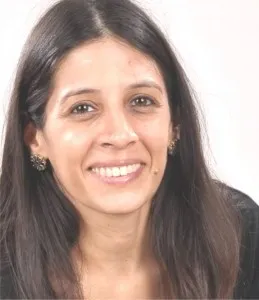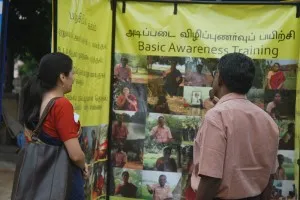[TCI-Changemakers] Tara Thiagarajan of Madura Micro Finance - I

The ThinkChange India staff is committed to providing our readers with interviews with people we believe are at the brink of something special but have for the most part been overlooked by the mainstream media. Readers will be able to see other conversations under our TC-I Changemakers tag.
In this edition of TCI-changemaker Badhri Jagannathan interviews Dr. Tara Thiagarajan of Madura Micro Finance, a company providing microfinance as well as knowledge and market opportunities through its microeducation and micromarkets products to 400,000 women in rural Tamil Nadu. Dr. Tara is a scientist whose interests encompass understanding complex systems and using a science based approach to solve large scale human problems. She is also a visiting scientist at the National Centre for Biological Sciences in Bangalore where she works on understanding how distributed electrical activity gives rise to perception and behaviour. She holds a PhD in Neuroscience from Stanford University as well as a BA in Mathematics from Brandeis University and an MBA from the Kellogg School of Management.
What is the founding philosophy behind Madura Micro Finance (MMF) and what are its core principles? How is MMF unique or different from other MFIs?
Madura differs from other MFIs in that its mission is outward focused – to bring about socioeconomic transformation. Many of India’s MFIs will define their mission as ‘To be the No. 1 Microfinance Institution in India’. What it means to be outward focused is that we have to constantly build our understanding of the system we are trying to transform and alter our strategies with this understanding. In this sense we operate like an evolving organism and our product offerings are beginning to increasingly extend beyond the realm of microfinance.
Madura’s founding philosophy is that money can only be turned into progress when the mind that takes the money is able to make it work in innovative and clever ways. Consequently there has always been a dual focus on expansion of mind and access to capital. Much of our effort goes into thinking of ways to facilitate more productive and innovative use of microfinance.
This also means that we have a very people focused approach. We recruit many of our field staff among our borrower base and develop them to rise to positions of significant responsibility, encouraging them to expand their minds so that they can expand the minds of others in their communities. Today we even have a few women who were at one time working for daily wages earning 1000 Rs a month that have risen to management positions handling teams of 200 people and loan portfolios between 1 and 2 million dollars.
In the context of microfinance one of our founding principles is also that access to capital has to be at a reasonable rate that can result in real returns. We therefore strive to develop and maintain an innovative low cost model that is profitable and scalable. We lend at the lowest rates in the industry. This is particularly important since most microenterprises make lower than average returns if you figure labor costs in the calculation.
MMF’s microeducation and micromarkets products include dissemination of information through audiovisuals, newsletters and classifieds hoping to introduce new opportunities and inspire entrepreneurship. How successful has this effort been? Any insightful examples you would like to share in this regard?
The goal of the microeducation products are to seed new ways of thinking on a large scale through the digital medium in micro chunks. Our first products are just being tested but we are very excited about what we are seeing.
Our first program is a 15 part ‘mini MBA’ for the illiterate and semi-literate audience. To establish the emotional connect we have created a well researched full length feature ‘Shakti Pirakkudhu’ or in English ‘Shakti Rising’ that introduces an inspirational character based on the real lives of our women borrowers. They watch the movie and then begin with the mini MBA program, which uses scene clips that centre around this character to teach business principles. The results we have seen so far in how the audience relate to the character and the level of recall have been remarkable. They talk about her as someone they know and remember every detail of what she did.
The micromarkets products have a different goal. Here the intent is to foster trade links between local communities. The rural ecosystem is very fragmented – most of our borrowers run home based businesses with no store front or advertising and three quarters of them do not transact beyond a 5 km radius. Only 2% of our rural microentrepreneurs venture beyond 20 kms to sell. This means that they access tiny markets of typically no more than a few thousand people and often just in the hundreds. This is very limiting. Most efforts focus on finding urban markets for rural products. Typically this is for handicrafts. However more generally we have found that the people who like and want rural products the most are other rural people. And while there are more rural than urban folk in India, people in one village often have no idea what is available two villages over.
The classifieds newspaper has huge access into the interiors of rural Tamil Nadu relative to other print mediums. It reaches 400,000 households and is shared with friends and neighbours. It is only a few months old but we are hearing a lot of exciting stories. People who only sold products to their neighbours have suddenly expanded their market to all the surrounding villages and people are excitedly reporting that they got orders from far away – up to 200 kms even!
Your website addresses microeducation and micromarkets as “products”. Do your customers pay for it? If so what is the business model surrounding it?
Absolutely. They have to be products or they would be highly limited in their scalability. We are a for-profit business. Our revenue model is twofold. In the case of

microeducation, we will charge nominally for the program. However we will also sell advertising – which means we will play ads at the beginning and end of the program when people are waiting for the group to start and milling around before they leave.
In the case of our Classifieds, each of our borrowers can place a certain number of ads a year for free and after that they have to pay. The primary revenue however comes from large ads placed by companies seeking to access this audience. Circulation of course is free. It’s not very different from the way local newspapers work in the US.
Can you please elaborate on Mini-MBA certificate program?
The mini MBA is the first of our microeducation programs and I’m very excited about it. It’s easily scalable since to run it only requires someone who knows how to turn on and off a DVD player. The business messages are very contextual and well developed and are the result of many years of research by Madhu Viswanathan at the University of Illinois at Urbana Champaign profiling subsistence marketplace entrepreneurs.
This program has taken over two years to develop. The goal was to take Madhu’s teaching and adapt them to the digital medium in a way that creates emotional context around the teaching messages so that the audience relates better to them and remembers them more easily. That’s how the idea of the film evolved. The movie Shakti Pirakkudhu (Shakti Rising in English) was developed with the intent of creating a realistic role model that would be the thread through the program. A lot of effort went into cleverly weaving the business messages into the script and a lot of footage was shot that was for the mini-MBA that didn’t make it into the film.
Given that participation is a very important element of learning, another aspect that’s been built into the program are opportunities for the class to interact among each other meaningfully. In the absence of a live teacher this has to be done very cleverly so that the class doesn’t just skip the participation sections. A great deal of time went into observing the way the audience reacted to the screen until a way was found to ensure that it guided self-regulated discussion in the classroom.
We’ve had a fantastic and creative team, Srivatsa Marthi and Anand Balagopal from Madura, Madhu Viswanathan, Gajendiran and Venkatesh from Marketplace Literacy Project and Usha Rajeswari from Prakrithi JIVA Media.
Your website mentions that “[Madura Micro Finance has] the highest cost efficiency worldwide, which allows us to deliver a range of financial products profitably at the lowest rates on the market.”. How do you achieve your cost efficiency and how does it tell upon the interest rates at which you lend? What is your typical interest rate?
Madura’s average lending rate is between 19% and 20% on a diminishing balance with no other fees. The industry range is 28% to 40%. This is possible because we have the proud distinction of having the highest operational efficiency worldwide at about 4%. The next best in the industry is upwards of 7%. The biggest reason is that we don’t employ full time staff to go door to door for weekly collections as is the industry practice. Rather we have a monthly repayment model and use women who were former borrowers to facilitate group meetings and compensate them based on the number of meetings they facilitate. It’s a variable pay model that doesn’t have any fixed overhead. The group members collect the dues at the group meeting and three representatives come to the nearest branch office to remit the money on behalf of the group. Other factors that contribute are high customer and employee retention and an organization-wide culture of cost prudence.
The second part of this Interview will be posted shortly…






